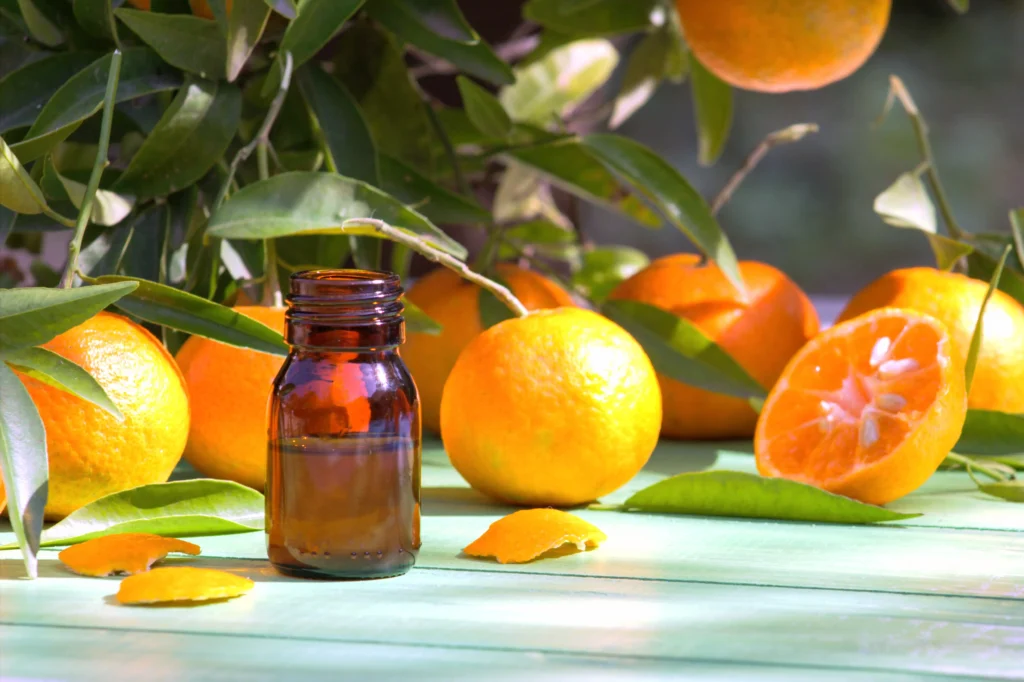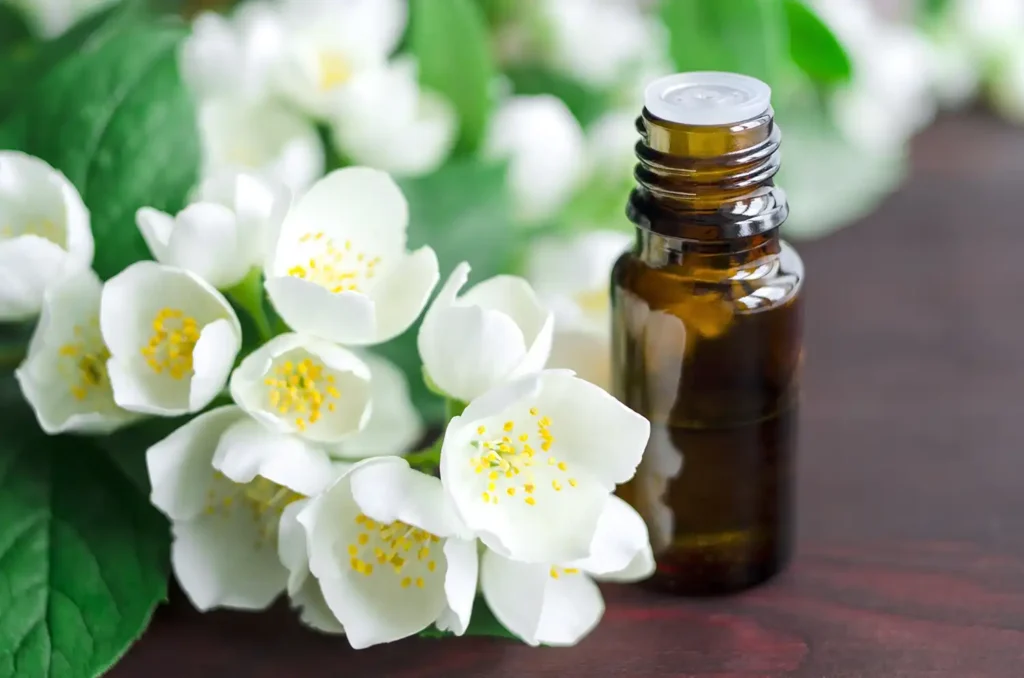Neroli essential oil is a versatile and powerful tool for improving your feeling of good health and well-being. Extracted from the fragrant blossoms of bitter orange trees (Citrus aurantium), Neroli oil has a wide range of potential benefits and uses.
In this post, we’ll cover the top 10 benefits of using Neroli essential oil. As well as how including it with other essential oils in your routine can boost your overall feelings of health and well-being.
Neroli essential oil offers many potential benefits that are worth exploring. From its calming and relaxing effects to its ability to help improve the appearance of the skin and help those coping with menopausal symptoms.
An Introduction to Neroli
Before we dive into the benefits of Neroli essential oil, let’s learn a little more about Neroli and where it comes from…
Citrus aurantium is a type of citrus tree that is commonly known as the bitter orange tree. It is native to Asia and the Middle East and is the source of several different products, including Neroli essential oil, derived from the tree’s orange blossom, and Petitgrain essential oil, which is distilled from the leaves and twigs.
The fruit from Citrus aurantium trees are not typically eaten fresh as they are incredibly sour and bitter, but they are used in producing marmalade and other products. In addition to its culinary and aromatic uses, Citrus aurantium is often used in traditional medicines for its various health benefits.
What is Neroli Essential Oil?
Neroli essential oil is a fragrant member of the citrus essential oils family and is derived from the orange blossom of the bitter orange tree. It is also sometimes known as Neroli Bigarade.
It is extracted through steam distillation, which uses steam to distil the oil from the orange blossoms. It has a unique, sweet, fresh and floral scent and is commonly used in perfumery and aromatherapy. It is still included in traditional Eau de Cologne.
According to tales of legend, Neroli is named after a 16th-century Princess, Anna Maria de la Tremoille, Princess of Nerola, Italy, who was known for her love of the orange blossom aroma. Legend tells us that she used the flowers and oil to add aroma to her bathwater, though to have given rise to the term “neroli water”.
She also soaked her gloves in the bathwater. These were elbow-length leather gloves, and she put them on as she got out of the bath so that they would dry on her arms. This made them a perfect fit that flattered her delicate arms. As she danced around the ballrooms, the aroma of Neroli would follow her. Inhaled Neroli oil is considered a narcotic, and everyone in the room would have been entranced by her!
Orange blossom represents purity and is traditionally worn in bridal headdresses. However, interestingly, in Spain, the blossom was previously worn by soliciting ladies of the evening to be easily and discreetly identified by potential customers!
The Process of Extracting Neroli Oil
Distillation plays a crucial role in the production of Neroli essential oil. The distillation process involves using steam to distil the volatile aromatic oils from the fragrant white flowers of the Neroli plant. The steam breaks down the cells of the flowers, releasing the volatile aromatic chemicals to form the essential oil. The oil and water vapour is then passed through a cooled condenser, which separates the oil from the water. The oil is then collected, and the water is used as flower water.
The steam distillation process is generally considered one of the most effective methods of obtaining essential oils from plants. The flowers’ delicate fragrances and many therapeutic properties can be collected efficiently with expert distillation. It is also a relatively simple and cost-effective method, making it a popular choice among essential oil producers.
The Role of Distillation in The Production of Neroli Essential Oil
Without steam distillation, extracting the essential oil effectively from the Neroli plant without using a solvent would be difficult. Steam distillation allows for the oil’s beautiful fragrances and therapeutic properties to be captured without using chemical solvents. Steam distillation is popular among essential oil manufacturers because it’s simple, cost-effective, and efficient.
The Chemical Composition of Neroli Essential Oil
Neroli essential oil’s chemical makeup varies by bitter orange tree species, region, and distillation method. However, Neroli oil generally contains a high concentration of monoterpenes, sesquiterpenes, alcohols and esters. It also contains small amounts of other compounds, such as aldehydes, ketones, and phenols.
The specific chemical constituents of Neroli essential oil can significantly impact its therapeutic properties. For example, the monoterpenes and sesquiterpenes in the oil contribute to its potentially antiseptic, calming and relaxing effects, while the alcohols and esters contribute to its skin-benefiting properties.
Understanding the chemical constituents of Neroli essential oil makes it possible to understand its potential benefits and uses better.

The 10 Benefits of Neroli Essential Oil on The Body and Mind
What is Neroli Oil Used For?
1. Reducing Stress & Anxiety
Neroli essential oil is effective for treating anxiety and reducing stress due to its calming and relaxing properties.
2. Insomnia & Sleep Problems
The calming effects of Neroli oil make it effective for treating those coping with insomnia and improving their sleep quality. When used in aromatherapy, it can help to induce a state of relaxation and promote restful sleep.
3. Skin Conditions
Neroli essential oil is known for its beneficial effects on the skin. In skincare, it is often used in formulations to help encourage improved skin tone and texture, reduce the appearance of scars and stretch marks, and calm inflamed skin.
4. Pain Relief
Neroli oil is believed to have pain-relieving and anti-inflammatory properties, making it a consideration for treating menstrual cramps and headaches. When used in aromatherapy, it can be good in blends for those coping with pain and discomfort during periods.
5. Depression
Some studies have suggested that Neroli oil may have antidepressant effects, making it effective for treating depression. Inhaled Neroli oil is considered to help improve mood and promote a sense of well-being.
6. Neroli May Help To Reduce Blood Pressure
Studies have suggested that Neroli oil may have hypotensive effects on hypertensive individuals, which may lower high blood pressure and reduce cortisol levels. This will help to balance the pulse rate as well. There is a double benefit because decreased salivary cortisol levels are linked with increased immune response. (Effects of Inhalation of Essential Oil of Citrus aurantium).
Be aware that if you already have very low blood pressure, Neroli may make your blood pressure drop further. If you are on high blood pressure medication, check with a health professional first.
7. Digestive disorders
Neroli oil is believed to have antispasmodic and carminative properties, making it effective for treating digestive disorders such as bloating, gas, and indigestion. Its anti-inflammatory properties will also benefit the gut.
8. Nervous disorders
The calming abilities of Neroli oil on the senses make it a good choice for those coping with nervous disorders such as nervous tension and agitation.
9. Headaches and migraines
Some studies have suggested that Neroli essential oil may effectively treat headaches and migraines for some individuals.
10. Neroli May Help Menopause Symptoms
Researchers found that Neroli can benefit women experiencing menopause symptoms. A study on women with menopausal symptoms found that inhaling Neroli essential oil for five minutes daily for five days reduced symptoms and increased sexual desire. (National Library of Medicine.)
Many postmenopausal women report they experience low libido and a decrease in their sexual desire, often because of feeling less attractive with changes in their body. Therefore, postmenopausal women could consider using a mixture of Neroli and essential oils like Rose and Sandalwood.
Although Neroli oil is helpful for treating specific health conditions, speaking with a healthcare professional or aromatherapist is recommended before using it. Improper usage might result in side effects.
What Does Neroli Oil Smell Like?
Neroli oil is derived from the flowers of the bitter orange tree, and its scent is typically described as floral, citrusy, and slightly spicy. The oil is often used in perfumes and other scented products and is known for its calming and uplifting effects on a poor mood.
Some people describe the scent of Neroli oil as similar to orange blossoms, with hints of jasmine and rose essential oils. Others may detect a slightly spicy or woody note in the scent from the oil’s chemical composition.
Overall, the scent of Neroli oil is highly regarded for its delicate, floral aroma and ability to evoke a sense of calm and well-being.
What Scent Does Neroli Go With?
Neroli blends well with other essential oils, including lavender, rose, jasmine, sandalwood, and ylang-ylang. These essential oils can help enhance and complement Neroli oil’s floral aroma, creating a pleasant and soothing fragrance. Neroli oil blends well with lemon, orange, and grapefruit oils to produce a refreshing, uplifting scent with citrusy overtones.
It’s important to note that all essential oils should be blended in the appropriate proportions to avoid overpowering the final fragrance.
Is Neroli a Feminine Scent?
While some people may consider Neroli a feminine scent, this is ultimately a matter of personal preference. Some people may find it to be more masculine or unisex, while others may not associate a gender with its scent at all. Neroli is a beautifully complex, intricate aroma, ubiquitous in its appeal.

How To Use Neroli Essential Oil
The main methods for using Neroli oil are through inhalation and topical application.
Neroli oil, when inhaled or applied topically with a carrier oil to pulse points, can reduce stress, promote relaxation and ease anxiety. Try adding a few drops to a diffuser or using a cotton ball.
To avoid skin irritation, dilute Neroli oil with a carrier oil before applying it.
Neroli essential oil, when used topically, can be helpful in blends to enhance skin tone and texture and diminish scars and stretch marks.
In addition to these methods, Neroli essential oil can be used in other ways and is often found in many skincare products and perfumes.
What are The Benefits of Neroli Oil on the skin?
In addition to its use in aromatherapy, Neroli essential oil can be used in skincare products for different skin types, including oily skin. A formulation for oily skin can be further improved by blending with Geranium essential oil in Hazelnut oil.
In cosmetic products, it is ideal to use in face masks as the gentle aroma will not irritate by being so close to the eyes and nose. It is known and is frequently used in formulas to encourage the balance of sebum production for both oily and dry skin. This known property is enhanced further when Neroli is blended with Geranium essential oil. This blend may also help to reduce thread veins.
When used in skincare products, it is often used to help improve the skin’s tone and texture, reduce the appearance of scars and stretch marks, and calm inflamed skin. Combined with other anti-inflammatory essential oils such as Frankincense, it is helpful in blends treating conditions like acne and oily skin. The Pakistan Journal of Biological Sciences reported that Neroli’s high limonene content effectively combats bacteria that cause acne. Limonene also has anti-inflammatory and antioxidant activities.
It is generally known for its powerful antibacterial properties and anti-inflammatory properties, making it effective for supporting those coping with conditions such as inflamed eczema and psoriasis.
Scar reduction: Neroli oil is well known for its ability to improve the appearance of scars in blends. It is considered to help reduce scar visibility and enhance skin appearance in skin care, especially when combined with Shea Butter and other essential oils like Palmarosa. This study (Biological Activities and Safety of Citrus spp. Essential Oils) on the biological activities of citrus essential oils came out with some fantastic results.
Neroli oil is a potent antioxidant that reduces skin ageing and promotes cell regeneration. This is ideal when considering formulations for improving existing scar damage and slowing down fine lines and wrinkles. To use Neroli oil in skincare, add a few drops to your favourite plain moisturiser or face oil.
Always dilute with a carrier before applying it to the skin to avoid irritation.
Does Neroli Oil Tighten Skin?
Neroli is said to have skin-tightening, gently astringent properties, so it may help to improve the appearance of loose or sagging skin. This is because it has compounds thought to stimulate collagen production, which is necessary for skin structure and elasticity. Adding Neroli to Pumpkin seed oil is an excellent idea, as the vegetable oil’s zinc may also help condition and lift the skin.
Is Neroli Good for Wrinkles and Anti-ageing?
Neroli has commonly been used in formulas to reduce wrinkles with its potential to boost and support collagen production. This protein strengthens and firms the skin, and Neroli’s compounds are generally considered to help stimulate its production.
As we age, our body produces less collagen, which can lead to wrinkles and sagging skin. Anything that supports collagen production can reduce fine lines and wrinkles, keeping skin smooth and radiant.

Frequently Asked Questions about Neroli Essential Oil
Can I use Neroli oil on my face?
Yes, you can use Neroli oil on your face. However, diluting essential oils before applying them to your skin is always best, as they can be very potent. You can dilute Neroli oil with a carrier oil, such as almond or jojoba oil, before applying it to your face. It is also a good idea to test on a small skin patch first to ensure you do not have any adverse reactions to the oil.
Is Neroli the same as Bergamot?
No. Whilst they are both from the same botanical family of citrus oils (Rutaceae family), Neroli and Bergamot are two different essential oils. Neroli is derived from the flowers of the bitter orange tree, while Bergamot is derived from the rind of the bergamot orange. Neroli has a sweet, floral scent, while bergamot has more citrusy overtones with just a hint of spice.
Both oils are used in perfumes and aromatherapy but have different properties and uses. Click the link to find out more about Bergamot essential oil.
What is the difference between Neroli oil and Orange Blossom oil?
They are both citrus essential oils derived from the bitter orange tree (Citrus aurantium). However, it is the extraction process that is very different.
Neroli oil is steam distilled from the flowers of the tree;
Orange Blossom oil is solvent-extracted from the tree’s blossoms.
The steam-distilled Neroli is considered to be superior for perfumes, therapeutic use and skin care. The solvent-extracted oil is more often used in general home fragrances. It’s important to differentiate between steam-distilled and solvent-extracted products when buying. Some vendors may try to sell a cheaper solvent-extracted oil at a higher price by labelling it as a premium steam-distilled oil.
Safety Considerations When Using Neroli Essential Oil
Pregnancy and breastfeeding: Neroli essential oil is considered safe to use during pregnancy and breastfeeding. However, remember that hormonal changes may cause sensitivity to many ingredients you were previously okay with, especially citrus oils. Please do a patch test first and reduce the amount of oil used in blends.
Sensitive skin: Always conduct a skin patch test for sensitive skin. Neroli essential oil can cause irritation when applied directly, without dilution, with a carrier oil or cosmetic product.
Allergies: Some individuals may have a citrus allergy or may be allergic specifically to Neroli essential oil or other ingredients in the oil. If you’re allergic, especially to citrus, consult a healthcare professional or aromatherapist before using.
Drug interactions: Neroli essential oil may interact with certain medications, such as blood pressure, sedatives or anti-anxiety medications. Before using Neroli essential oil, if in doubt, it’s recommended to speak with a healthcare professional or aromatherapist to prevent any possible interactions with medications.
Conclusion
In conclusion, Neroli essential oil is a beautifully versatile and effective oil in the aroma toolbox for improving your feelings of good health and well-being. Using just a drop of Neroli oil in your daily routine can promote a sense of relaxation and calmness, making it an easy and natural way to enhance your well-being. Neroli oil is a potent addition to your health wealth and wellness routine, whether used in skincare, aromatherapy, or diffused. Give it a try and see the positive effects for yourself.






